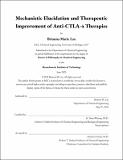Mechanistic Elucidation and Therapeutic Improvement of Anti-CTLA-4 Therapies
Author(s)
Lax, Brianna Marie
DownloadThesis PDF (6.018Mb)
Advisor
Wittrup, K. Dane
Terms of use
Metadata
Show full item recordAbstract
Anti-CTLA-4 antibodies have successfully elicited durable tumor regression in the clinic; however, long-term benefit is limited to a subset of patients for select cancer indications. The incomplete understanding of their mechanism of action has hindered efforts at improvement, with conflicting hypotheses proposing either antagonism of the CTLA-4:B7 axis or Fc effector-mediated regulatory T cell (Treg) depletion governing efficacy. Here we report the engineering of a non-antagonistic CTLA-4 binding domain (b1s1e2) that depletes intratumoral Tregs as an Fc fusion. Comparison of b1s1e2-Fc to 9d9, an antagonistic anti-CTLA-4 antibody, allowed for determination of the separate contributions of CTLA-4 antagonism and Treg depletion to efficacy. Despite equivalent levels of intratumoral Treg depletion, 9d9 achieved more long-term cures than b1s1e2-Fc in MC38 tumors, demonstrating that CTLA-4 antagonism provided additional survival benefit. Consistent with prior reports that CTLA-4 antagonism enhances priming, treatment with 9d9, but not b1s1e2-Fc, increased the percentage of activated T cells in the tumor-draining lymph node (tdLN). Treg depletion with both constructs was restricted to the tumor due to insufficient surface CTLA-4 expression on Tregs in other compartments to elicit Fc effector-mediated Treg depletion. Through intratumoral administration of diphtheria toxin (DT) in Foxp3-DTR mice, we show that depletion of both intratumoral and intranodal Tregs provided even greater survival benefit than 9d9, consistent with Treg-mediated restraint of priming in the tdLN. Lastly, we engineered a CTLA-4-targeted enzyme fusion as a potentially translatable approach for combined intratumoral and intranodal Treg depletion. Preliminary data suggest that CTLA-4 targeting increases local Treg death as a result of proximal enzymatic activity, but further characterization remains to be done. Overall, our data demonstrate that anti-CTLA-4 therapies require both CTLA-4 antagonism and intratumoral Treg depletion for maximum efficacy - but that future therapies capable of depleting intranodal Tregs could show superior efficacy, even in the absence of CTLA-4 antagonism.
Date issued
2023-06Department
Massachusetts Institute of Technology. Department of Chemical EngineeringPublisher
Massachusetts Institute of Technology